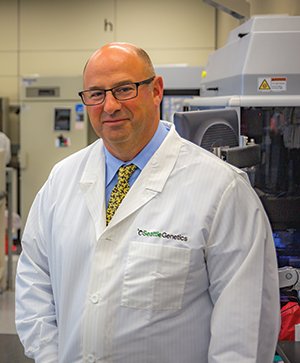Clay Siegall, Ph.D. ’88, was 19 years old when his father was diagnosed with brain cancer. “Life changes as you know it,” Siegall says. The University of Maryland premedical student — one of five siblings — stepped in on occasion to help, accompanying his father to the oncologist. It was there that his career began to take shape.

“I would ask the oncologists, ‘Where do you get your tools? Where do you get your medicines?’” Siegall says. His advisors at the University of Maryland, with whom he shared his curiosity, explained how best to consider a path toward research. “I’m 19 years old, and I’m just learning about the world of medicine and research,” Siegall recalls.
What he discovered was biomedical science. A six-month internship with the National Institutes of Health (NIH) opened up a world of tools and therapies — and possibilities. “I wanted to go to grad school and get a Ph.D., and that became my new mission: to learn how to make medicines that oncologists could use,” he says.
The George Washington University (GW), which maintained a close relationship with the NIH, was “the perfect spot.” As Siegall explains, many of the NIH scientists were adjunct faculty members at GW, and the Potomac, Maryland, native could stay close to home to support his family. “My mom was having a tough time,” he says, “and partway through my second year of grad school, my dad passed away.”
Siegall entered graduate school in the genetics department and conducted his research within GW’s Institute for Biomedical Sciences, where he worked under Ajit Kumar, Ph.D., professor of biochemistry and molecular biology at the GW School of Medicine and Health Sciences. Kumar, Siegall says, further strengthened the link between GW and the NIH and introduced the young researcher to “very interesting science.”
“He was my Ph.D. mentor and helped guide the early parts of my career and my education,” Siegall recalls. “He helped continue my introduction to the NIH through connections with NIH scientists.”
Siegall, in support of his GW mentor and the school’s mission of advancing research, educating a diverse health care workforce, healing, and promoting a culture of excellence, later contributed a six-figure gift to Kumar and his lab in the Biochemistry and Molecular Genetics program.
Following graduation, Siegall returned to the NIH for a postdoctoral fellowship and, two years later, a full-time position. “I published a number of papers on my work in targeted cancer therapy,” he says, and his research attracted the attention of pharmaceutical companies. He turned down several offers, but Bristol-Myers Squibb offered him what he couldn’t turn down: a position with a budget for lab space and slots for new employees. “They really laid out a plan that allowed me to go after the vision I had of making therapies,” he says.
Standard cancer treatments typically involve cytotoxic drugs, agents that indiscriminately kill all cells that divide, whether cancerous or healthy. Targeted cancer therapies — Siegall’s research focus — are more refined. He sorts them into three categories: those drugs that target the outside of the cell, those that target the inside of the cell, and those that target the immune system. “I think all three ways of targeting cancer will represent the future of cancer therapies,” he says.
When new management took over at Bristol-Myers Squibb and made a brief departure from targeted therapies, Siegall, who had transferred to Seattle with the pharmaceutical giant, struck out on his own. He started Seattle Genetics, Inc. Today, the company has 12 cancer medications in development and one approved product, ADCETRIS, which is commercially available in more than 60 countries. “It’s an antibody with a chemotherapy attached, so you can deliver the chemotherapy on the back of a vehicle that targets cancer, sparing healthy cells,” Siegall explains.
Seattle Genetics has more than 250 sites around the globe for clinical trials, and one of those sites brought Siegall, in a roundabout way, back to GW. The H. Lee Moffitt Cancer Center and Research Institute at the University of South Florida in Tampa was once the home of renowned cancer researcher and lymphoma expert Eduardo Sotomayor, M.D., with whom Siegall worked. “Eduardo is well known to Seattle Genetics, and vice versa,” Siegall says. In 2015, Sotomayor joined Siegall’s alma mater as the director of the GW Cancer Center (GWCC), a major new initiative promoting cancer-related activities, including basic science and clinical research, patient care, and policy. With an aim of acquiring a prestigious National Cancer Institute designation, GWCC prioritizes revolutionary approaches to cancer, such as immunotherapy.
While Seattle Genetics specializes in medications targeting the cell surface, like ADCETRIS, it is expanding to include drugs that zero in on the inside of the cell and others that target the immune system. All of the therapeutic approaches, Siegall says, can potentially benefit the patient.
“We are very eager to treat cancer patients in the best way possible,” he says.



